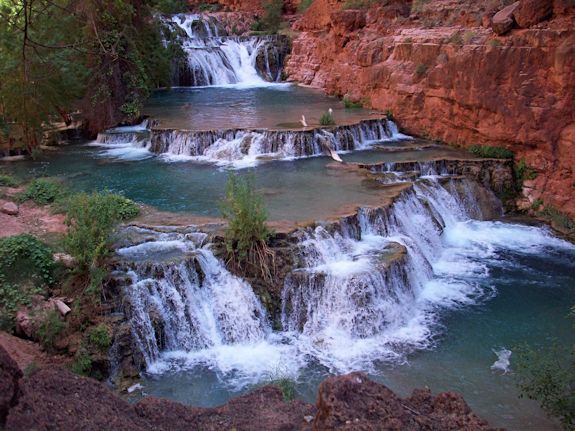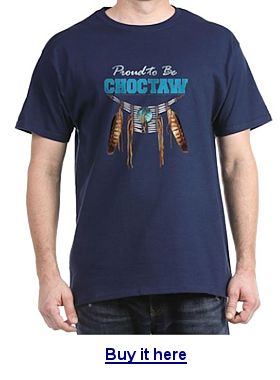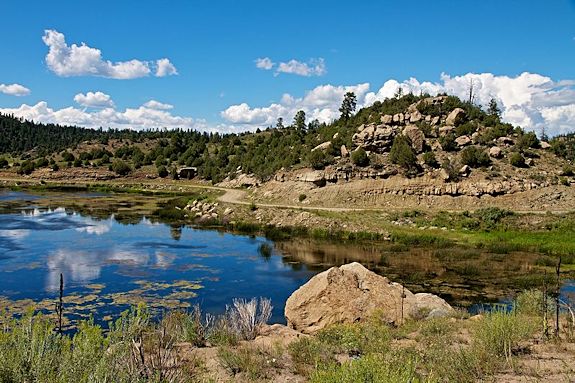The Hualapai Tribe is a federally recognized Indian Tribe located in northwestern Arizona. “Hualapai” (pronounced Wal-lah-pie) means “People of the Tall Pines.” In 1883, an executive order established the Hualapai reservation.
US Tribes H to J
Click on a letter of the alphabet to go to US Tribes starting with that letter. Where known, the official name is used. Linked tribal names go to their profile index page which will contain more links to sections of our site where you can find articles about that tribe and related tribes.
KEY:(F)= Federally Recognized, (S)= State Recognized, (T)= Terminated, (U)= Unrecognized, (M)= Mesoamerican Civilizations,(P)= Petitioning for Recognition, (C)= Canadian Tribes, (E)= Extinct, (IRA)= Indian Reorganization Act
Indian tribes are unique legal entities in the United States and are distinct political communities with extensive powers of self-government. Tribal sovereignty predates the U.S. government. Treaties, federal statutes and executive agreements over the past 200 years have established a special trust relationship between tribes and the federal government. The federal Bureau of Indian Affairs (B.I.A.) has been designated by the Secretary of the Interior as the primary agency to protect tribal interests and administer trust responsibilities. Inclusion on this site does NOT mean an endorsement has been made for recognition of any particular tribe. All entities claiming to be US indian tribes that we are aware of have been included for completeness. Where known, we have indicated official tribal status with our Key Chart, based on information released by the BIA as of May 2016. In many cases we have not verified the validity of the claim of tribal status, and leave it to your own common sense or further research to validate tribal claims.Alternate names in parenthesis are either older names that were once used to identify that tribe, or they are misspellings.
Links to tribal profile pages are at the bottom of the page
us tribes starting with H
Haida:
Tlingit and Haida Indian Tribes of Alaska
Haliwa-Saponi
Haliwa-Saponi (North Carolina) (S)
Haliwa-Saponi Tribal School
Hassanamisco:
Hassanamisco (Massachusetts) (S)
Havasupai:
Havasupai Tribe of the Havasuapi Reservation (Arizona) (F)
Hidatsa: (Hinatsa, Hidasta)
Three Affiliated Tribes of the Fort Berthold Reservation (Mandan, Hidatsa, and Arikara Nation) (North Dakota) (F)
Ho-Chunk: (Hocak, Hochunk)
Ho-Chunk Nation of Wisconsin (F) (formerly the Wisconsin Winnebago Tribe)
Hoh:
Hoh Indian Tribe of the Hoh Indian Reservation (Washington)(F)
Hooopa (Hupa):
Cher-Ae Heights Indian Community of the Trinidad Rancheria (California) (F)
Hoopa Valley Tribe (California) (F)
Hopi:
Colorado River Indian Tribes of the Colorado River Indian Reservation (Arizona and California) (Mohave, Chemehuevi, Hopi and Navajo) (F)
Hopi Tribe of Arizona (F)
Houma:
United Houma Nation (Louisiana) (S)
Hualapai:
Hualapai Indian Tribe of the Hualapai Indian Reservation (Arizona) (F)
Huron:
Huron Potawatomi, Inc. (Michigan) (F) – See Nottawaseppi Huron Band of the Potawatomi
Wyandotte Nation (formerly the Huron Tribe)
—-
Hamilton Village
Hoonah Indian Tribe (IRA)
Huslia Tribe
Hydaburg Cooperative Tribe (IRA)
Haisla
Halkomelem (Halqomelem, Halqomeylem)
Han (Hän, Hankutchin, Han Hwech’in)
Hanesak
Hanis
Hare
Hatteras
Haudenosaunee
Hawaiian
Heiltsuk
Heve
Hiaki
Hinonoeino
Hochelagan
Holikachuk
Holkomelem
Homalco
Huarijio (Huarihio, HuarijÃo)
Huelel
Huichol (Huichola)(M)
Huichun
Hupa – See Hoopa
Hutyeyu
Hwech’in
—-[back to TOP)
us tribes starting with I
Illinois:
Illini (Illiniwek, Illinois) – See Peoria Tribe of Indians of Oklahoma
Indian Colony:
An Indian Colony is a Native American settlement associated with an urban area. Although some of them became official Indian reservations, they differ from most reservations in that they are located where Native Americans could find jobs in the white economy and originally formed without federal encouragement or sanction.
Indian colonies are especially common in
. As the Great Basin ecosystem is very fragile, native lifeways became untenable soon after white settlement due to livestock over-grazing, water diversions and the felling of Pinyon pine groves. At that time there were few official reservations in the area, and those were terribly run even by contemporary standards. Many Native Americans chose instead to seek jobs in white ranches, farms and cities. The areas in which they settled became known as Indian Camps or Colonies.
In some cases they owned the land they settled on, in other cases they settled on public land. Starting in the early twentieth century, the federal government began establishing Indian trust territories for the colonies on public land.Following the Indian Reorganization Act of 1934, many of the Indian colonies gained federal recognition as tribes.
Bridgeport Indian Colony (California) — See Paiute
Burns Paiute Tribe (Burns Indian Colony) (Oregon) — See Paiute
Ely Shoshone Tribe (Ely Indian Colony) (Nevada) — See Shoshone
Fallon Paiute-Shoshone Tribe (Fallon Indian Colony) (Nevada) — See Paiute and Shoshone
Las Vegas Paiute Tribe (Las Vegas Indian Colony) (Nevada) — See Paiute
Lovelock Paiute Tribe (Lovelock Indian Colony) (Nevada) — See Paiute
Reno-Sparks Indian Colony (Nevada)(F) — See Washoe, Paiute and Shoshone
Te-Moak Tribe of Western Shoshone Indians, Battle Mountain Band (Battle Mountain Indian Colony) (Nevada) –See Shoshone
Te-Moak Tribe of Western Shoshone Indians, Elko Band (Elko Indian Colony) (Nevada) –See Shoshone
Te-Moak Tribe of Western Shoshone Indians, Wells Band (Wells Indian Colony) (Nevada) — See Shoshone
Washoe Tribe of Nevada and California, Carson Community Council (Carson City Indian Colony) (Nevada) — See Washoe
Washoe Tribe of Nevada and California, Dresslerville Council (Dresslerville Indian Colony) (Nevada) — See Washoe
Washoe Tribe of Nevada and California, Stewart Community Council (Stewart Indian Colony) (Nevada) — See Washoe
Winnemucca Colony (Nevada) — See Paiute
Washoe Tribe of Nevada and California, Woodfords Community Council (Woodfords Indian Colony) (California) — See Washoe
Yerington Paiute Tribe (Yerington Indian Colony) (Nevada) — See Paiute
Inupiaq:
Inupiaq (Inuktitut, Inuit, Inupiat, Inupiaq, Inupiatun) (Alaska)
Iowa:
Iowa Tribe of Kansas and Nebraska (F)
Iowa Tribe of Oklahoma (F)
Iowa-Oto (Ioway)
Isleta Pueblo– See Pueblo Indians
Inca — See Ancient Indians
Ineseño (Inezeño)
Ingalik (Ingalit) – See Alaska Indians
Innoko
Innu- See Alaska Indians
Inuna-Ina
Iroquois
Ishak, Isleño, Isleta del Sur — See Pueblo Indians
Itza Maya (Itzaj, Itzah) — See Ancient Indians
Iviatim
Iynu—-[back to TOP)
us tribes starting with J
Juaneño:
Juaneño Band of Mission Indians (California)
—-
James Bay Cree – See Cree
Jemez Pueblo – Also See Pueblo Indians
Juaneno (Juaneño)
Juichun
The federally recognized Habematolel Pomo of Upper Lake have lived in central and northern California since before recorded time.
Hannahville Indian Community
22 ViewsThe Hannahville Indian Community is a Potawatomi tribe located in the south-central section of Michigan’s Upper Peninsula in Menominee Country, 20 miles west of Escanaba, MI and 95 miles northeast of Green Bay, WI.
The Havasupai Tribe of the Havasupai Reservation is a federally recognized American Indian tribe who has lived in the Grand Canyon for at least the past 800 years.
Ho-Chunk Nation of Wisconsin
22 ViewsThe Ho-Chunk Nation of Wisconsin, formerly known as the Wisconsin Winnebago Tribe, is one of two federally recognized tribes of Ho-Chunk people.
Hoh Indian Tribe
22 ViewsThe Hoh Indian Tribe are considered to be a band of the Quileutes but are recognized as a separate tribe. Located at the mouth of the Hoh River on the western Olympic Peninsula in Washington State, the tiny Hoh Indian Tribe is dependent on the fish and wildlife of the Hoh River for their subsistence and commercial economy. This federally recognized indian tribe takes it’s name from the principal river in their territory.
Hoopa Valley Tribe
22 ViewsThe People of Hoopa Valley are one of California’s first cultures. They came up the Trinity River into the rich valley which has always been the center of the Hupa World, the place where the trails return. Legends say this is where the people of the Hoopa Valley Tribe came into being.
Hopi Tribe of Arizona
22 ViewsThe federally recognized Hopi Tribe of Arizona lives in northeastern Arizona in twelve villages on three mesas.
Hopland Band of Pomo Indians
22 ViewsThe Hopland Band of Pomo Indians is a federally recognized tribe of Pomo people.
Houlton Band of Maliseet Indians
22 ViewsThe Houlton Band of Maliseet Indians belonged to the loose confederation of eastern American Indians known as the Wabanaki Alliance, together with the Passamaquoddy, Penobscot, Mi’kmaq, and Abenaki Indians. The Maliseet live primarily in Canada, especially New Brunswick, with one band across the border in nearby Maine.
Iipay Nation of Santa Ysabel
22 ViewsThe Iipay Nation of Santa Ysabel is a part of the larger Kumeyaay people that once populated much of the geographic area of present day San Diego County. On November 20, 2007, the Iipay Nation of Santa Ysabel, by a majority ballot vote of the General Membership, certified the adoption of a new Tribal Constitution for self-governance.
The Inaja Band of Diegueno Mission Indians of the Inaja and Cosmit Reservation is a federally recognized tribe of Kumeyaay Indians, who are sometimes known as Mission Indians.
The Ione Band of Miwok Indians is a federally recognized tribe of Miwok people in Amador County, California.
Iowa Tribe of Kansas and Nebraska
22 ViewsThe Iowa Tribe of Kansas and Nebraska is located along the Missouri River on an approximately 2,100-acre reservation straddling the borders of northeast Kansas (Brown County) and southeast Nebraska (Richardson County).
Iowa Tribe of Oklahoma
22 ViewsThe Iowa Tribe of Oklahoma is a federally recognized indian tribe which split off from the main Iowa Tribe now located in Kansas and Nebraska in the late 1800s.
Jackson Band of Miwuk Indians
24 ViewsThe Jackson Band of Miwuk Indians was first recognized by the Federal Government in 1898. The Tribe held a meeting in 1979 and established a formal government. They are a federally recognized tribe of Miwok people.
Jamestown S’Klallam Tribe
22 ViewsThe Jamestown S’Klallam Tribe is a federally recognized Salish indian tribe that resides on the northeastern portion of the Olympic Peninsula, in northwestern Washington.
Jamul Indian Village of California
22 ViewsSixty-five years ago a small band of Tipai found themselves with six acres upon which to settle – a tiny plot in the rolling hills east of the town of Jamul. After 65 years of tenacious endurance, the Jamul Indian Village of California was rewarded with their village finally being declared a reservation and federally recognized indian tribe.
Jena Band of Choctaw Indians
22 ViewsThe Jena Band of Choctaw Indians are native to the Southeastern United States and members of the Muskogean linguistic family, which traces its roots to a mound-building, maize-based society that flourished in the Mississippi River Valley for more than a thousand years before European contact. They are a federally recognized indian tribe.
Jicarilla Apache Nation
27 ViewsThe Jicarilla Apache Nation is located in the mountains and rugged mesas of northern New Mexico. The Jicarilla people were one of six southern Athabaskan groups who migrated out of Canada sometime between 1300 AD and 1500 AD.




